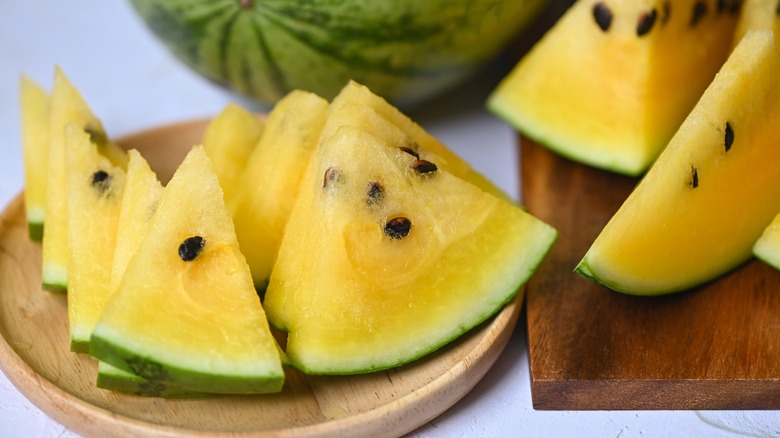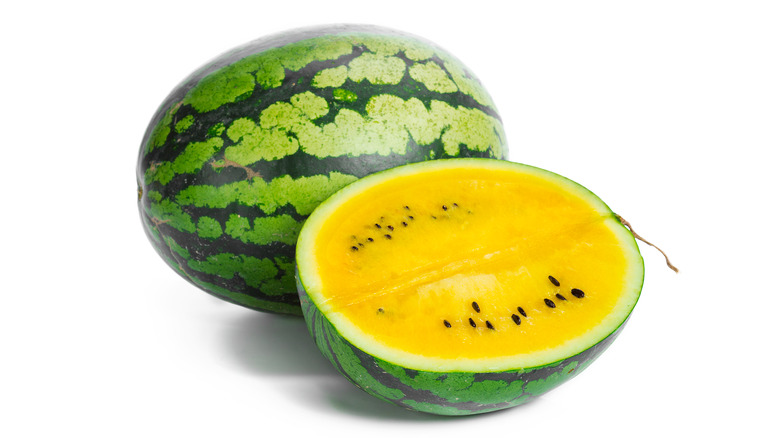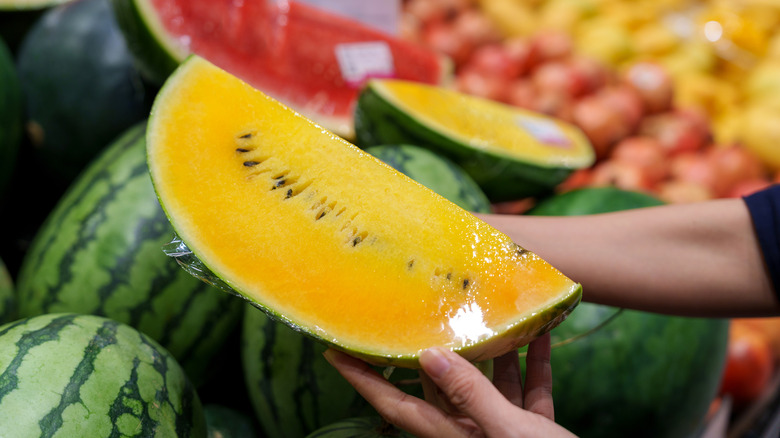Where To Find Yellow Watermelon And How To Choose The Best One
A cold, juicy watermelon slice is just what the doctor ordered on a warm summer day. Whether you're eating it by the slice or adding it to your 4th of July fruit salad, it's always a summer staple. Of course, when you think of watermelon, you likely picture a bright green rind with a red center, but surprisingly, there is another type you can enjoy: yellow watermelon. Depending on where you live, it's not always easy to find, but it has the same shape and rind as red watermelon, except the fruit's flesh is a vibrant yellow.
The biggest difference between red and yellow watermelon is the color; for the most part, the two fruits are the same, but yellow watermelons are slightly sweeter. This is good news because it means you can interchange the two fruits with ease, plus their nutritional benefits (low in fat and calories, keeps you hydrated, and improves heart health) are the same as well. One of the most exciting benefit of yellow watermelon is that it's a good source of vitamin A due to the addition of beta carotene.
Where to find yellow watermelon
If red and yellow watermelon are essentially the same, then you might question why they're two different colors. It's actually because the yellow variety is just a different seed that does not contain lycopene but does contain higher levels of beta carotene. Lycopene is a natural pigment found in produce, most commonly associated with tomatoes; it's why ketchup is red and tomato sauce always stains your plastic containers. It's also why watermelon has that pinkish-red hue, and when watermelon is missing lycopene, its flesh is yellow.
Yellow watermelon has roots in Africa, making its first appearance around 5,000 years ago, and it's not as widely available as red watermelon. Specialty groceries stores with large produce sections are more likely to carry this fruit, and even Trader Joe's tends to stock it during the summer months when it's at its peak production. You may have to ask around, but you'll almost certainly be able to find it throughout the United States. To find the best watermelon, you can use the same trick for yellow that you would for red watermelons: Check for its "field spot," or yellow belly, which is a discolored part of the melon that rested on the ground while it was growing. If the spot is large and yellow, then the melon is ripe; if it's small and white, the melon is less ripe and won't be as good.
How to choose a yellow watermelon
Within the yellow watermelon family, there are five varieties of yellow melons. They each differ slightly, so you might prefer one type of watermelon over the other. Yellow crimson is the most similar variety to that traditional red watermelon you're used to, but it has a little more sweetness to it. For a brighter yellow melon (maybe the best option if you plan to take food photos), try the desert king variety, which has more beta carotene than the other types.
The buttercup yellow melon is a type of seedless watermelon, but it's so much sweeter than a typical yellow variety. If this is the first yellow kind you try, you'll spend your whole life thinking this color tastes like a lollipop. On the other end of the sweetness spectrum is the yellow black diamond watermelon, with a sweetness that is much milder than the buttercup. And for a smaller watermelon — one you might be able to eat by yourself — try the yellow doll, which only weighs around five to six pounds but it's just as juicy and delicious.


